
Many get stuck on the basics of learning how to play guitar, but did you know that there are limitless possibilities when it comes to playing styles, even with something as straightforward as tuning? One of the most common alternate tunings is open D tuning, which creates a D major chord with the open guitar strings.
This tuning was originally developed for use with slide guitars, though it has made its way into the likes of popular folk, rock, and pop songs today. Below, we’ll unpack how to play open D chords so that you can incorporate these killer chords into your music.
What Is an Open D Chord?
An open D chord is a chord that’s played using open D tuning. Open D tuning is an alternate tuning that tunes a guitar to a D major chord. This way, when a guitar is strummed in open D tuning, a D major chord plays without requiring any fingers to be placed on the fretboard.
An open D chord is any chord that’s played utilizing this tuning arrangement. Most major chords are much easier to play in open D tuning than in root position since you only have to utilize a single finger across the fretboard.
Understanding Open D Tuning
As the name suggests, open D tuning refers to tuning a guitar to a D major chord. With standard tuning, a guitar is adjusted from lowest to highest string with the notes E A D G B E. Open D tuning adjusts these notes to produce D A D F# A D, utilizing the notes of a D major chord, D F# and A.
There are several open tuning styles, but open D is fairly popular due to its versatility when it comes to playing chords and using additional tools like a slide. Playing in open D means that you can perform any major chord by barring down a fret with one finger.
In order to understand which chord you’re playing, simply look to the fret on the low E string, which is now tuned to a D. The frets move up chromatically, or each by one semitone.
So, the open string represent a D major chord, first fret barred represents a D # major chord, second barred is a E major chord, third barred fret plays an F major chord, so on and so forth.
The Advantages of Open D Tuning
Standard tuning has its limitations. In order to transition from one chords to the next, you have to scramble your fingers into various chord configurations. With open D tuning, switching between chords is simply a matter of moving a barred fret (one finger laid flat, firmly pressing down on all of the strings) from one fret to the next.
For this reason, open D tuning is pretty popular with blues and “bottleneck” players who play slide guitar. Slide players can easily move from one chord to the next in open D tuning while getting a full, warm-bodied sound. You’ll hear this tuning all across folk, blues, and pop genres.
Examples of Open D Tuning In Music
Music theory can be a bit dry, but there’s nothing that will get you more excited about playing open D chords than hearing the potential music possibilities! Here are a couple of examples of popular songs that utilize this alternative tuning style:
- Buckets of Rain by Bob Dylan: Open chord tuning makes fingerpicking a bit easier since you’re automatically set to a particular key. This peaceful song embodies this to a T.
- Big Yellow Taxi by Joni Mitchell: This famous song is performed in open D tuning with a couple of barre chords and rhythmic challenges.
- Barcelona by George Ezra: This indie pop hit marked by gorgeous melodies is played in open D tuning.
- Motion Sickness by Phoebe Bridgers: Anyone can sing along to this heart-wrenching banger played in open D.
- Jive Talkin’ by Bee Gees: We most often see open D chords and tuning in folk or blues adjacent creations, but in this case, it was perfect for this classic disco hit!
The D Major Scale
Understanding the D major scale can help you make more sense of open D chords in terms of music theory. As with any major scale, the formula is built upon half steps (one semitone) and whole steps (two semitones).
The major scale is built by taking the root note (in this case D) and moving up whole step -> whole step -> half step -> whole step -> whole step -> whole step -> half step, sometimes called WWHWWWH. With this formula, we can outline the D major scale as:
D E F# G A B C
To build a major triad, we need the first, third, and fifth scale degrees of the major scale. Using our scale, we can determine that those are D F# and A. This is the reasoning behind open D tuning and why all notes on the open strings are tuned exclusively to one of these notes.
Feeling confused? You might find it easier to memorize the circle of fifths:
How To Tune Your Guitar To Open D Tuning
Tuning your guitar to open D is easy! All you have to do is use a tuning app, tuner, or reference tuned instrument to tune your guitar to D A D F# A D from lowest to highest string. If your guitar was in standard tuning, for example, you would make the following changes:
Low E → D
A → A (remains the same)
D → D (remains the same)
G → F#
B → A
High E → D
Don’t worry if you don’t have tuning resources available. You can use this video for reference:
Listen to each string and adjust the knobs on the headstocks until the pitch of each string matches your reference as closely as possible.
How To Use a Chord Chart
There are plenty of chords you can play in open D tuning. You can use these tips and tricks to help you read a chord chart:
- The diagram represents the neck upright, with the leftmost string being the low E, or in open D, the lowest D note. The rightmost string is the highest string.
- Xs represent strings that aren’t played with a particular chord.
- Os represent open strings.
- Dots on each fret represent finger placement. With some chord charts, there will be numbers within these small dots or circles which represent which finger they suggest using with the index finger being 1, middle finger being 2, ring finger being 3, and pinky being 4.
- First position is starting at the first fret. In other words, starting where you normally would on the neck of the guitar. Fifth position means starting on the fifth fret.
Common Open D Chord Shapes
Open D chords come in several shapes and sizes. There are several chord shapes that are considered movable, meaning they can be transposed up and down the neck by half-steps holding the same shape in different positions. Here are some of the most common open D chord shapes you’ll encounter while playing through a chord chart.
Barred or One-finger Chord Shapes
One-finger or barred chord shapes involve laying one finger flat across the fretboard so that you evenly press down each string on the same fret.
You can use your index finger to hold down the fret. Roll your finger back so that the frets are resting on the bony part of your finger to create a more stable barre chord shape like so:
You can determine which major chord you’re playing based on the note played on the lowest D string. Each fret is equivalent to one semitone or one step on the chromatic scale. For instance, the open string shape would be D major in open D tuning. Placing your barre on the first fret would create a D# major chord since you’re raising the entire chord by one semitone or half step.
Staggered
Another movable shape in open tuning is the staggered shape. To create this chord shape, place your index finger on the first fret of the F# string. Then, place your middle finger on the second fret of the low A string.
Inline
To build an inline shape, place your middle finger on the fifth fret of the low A string. Next, add your ring finger on the fifth fret of the F# string.
You’ll find that these common chord shapes come up time and time again in chord charts, so it’s a good idea to get used to how the feel moves up and down the neck of the guitar.
9 Open D Chords
Ready to put open D tuning to good use? Use these chords in open D tuning to build your next musical masterpiece:
Barre Chords
D Major:
Strum all open strings.
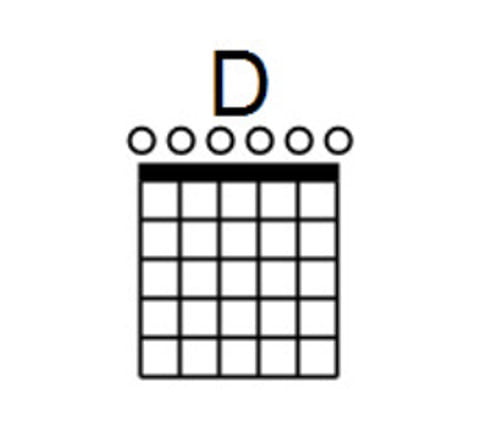
E Major:
Barre the second fret to play the E major chord
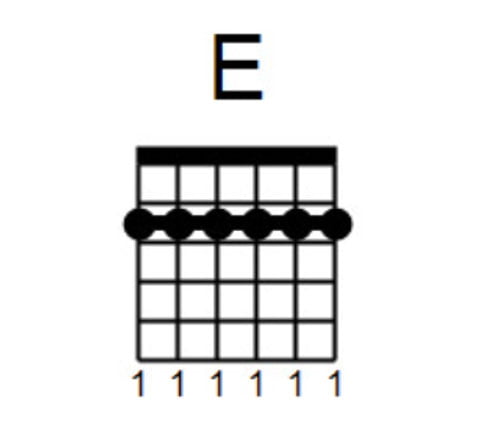
F Major:
Barre the third fret to play the F major chord.
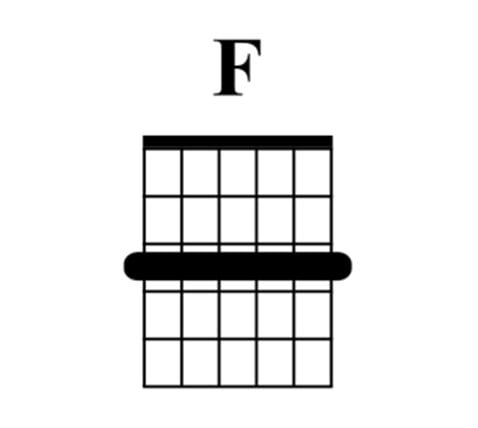
G Major:
Barre the fifth fret to play the G major chord.
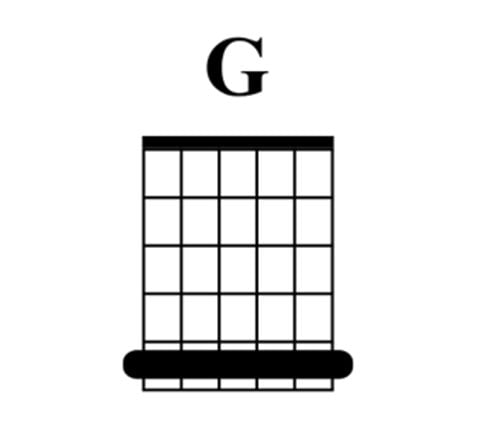
A Major:
Barre the seventh fret to play the A major chord.
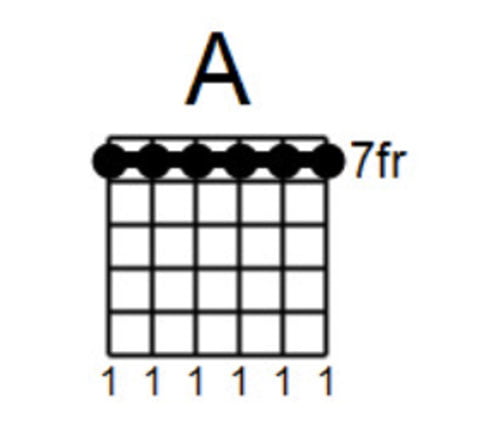
D Chords in Open D
We know playing a D major chord in open D tuning equates to strumming the open strings, but what if you’re looking for another variation of the D chord? Use these shapes to create other D chords in D tuning:
D Minor:
In first position, put your index finger on the fourth fret of the low D string and your middle finger on the third fret of F# string.
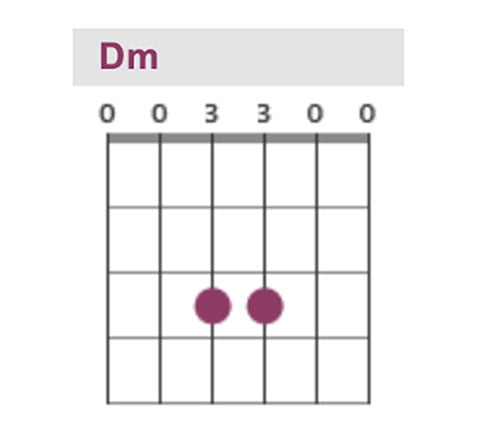
D Seven:
In first position, put your index finger on the third fret of the high A string.
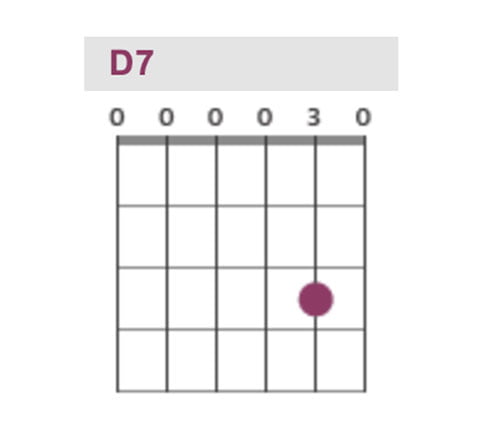
D Six:
In first position, put your index finger on the second fret of the high A string.
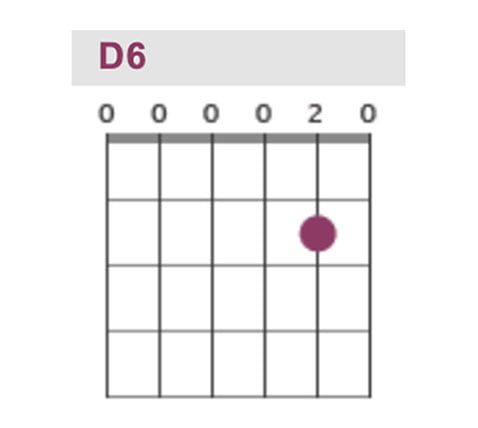
D Add Two:
In first position, put your index finger on the second fret of the highest D string (the high E string with standard tuning).
In first position, put your middle finger on the third fret of the high A string.
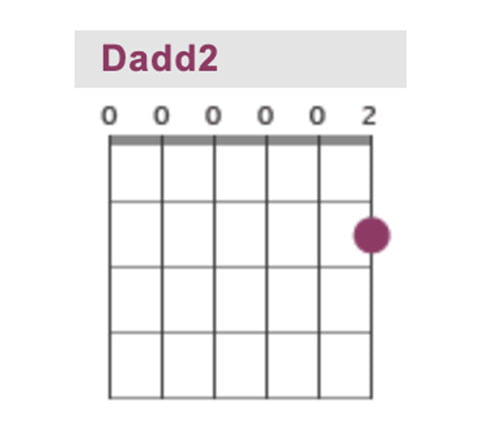
Building a Chord Progression in D Major
Not sure how to use open D tuning? Spark some ideas by starting with a simple chord progression. For reference, the chords of the D major scale are as follows:
I – D major
ii – E minor
iii – F# minor
IV – G major
V – A major
vi – B minor
vii° – C# diminished
Each chord is represented by a Roman numeral, with uppercase lettering representing major chords and lowercase letters distinguishing minor chords.
If you’re not sure where to start, opting for some combination of I, IV, and V chords is an excellent first step. In this case, this would be a D major chord, G Major chord, and A major chord which can be played like this in open D tuning:
D Major Chord – The I Chord or Tonic
To play this chord in open D tuning, all you have to do is strum the open strings, no fret placement is needed.
G Major Chord – The IV Chord or Subdominant
The G major chord can be played by barring down the fifth fret in open D tuning.
A Major Chord – The V Chord or Dominant
The V chord has the strongest relationship to the tonic, or D major chord, within the D major scale. To play the V chord in Open D tuning, bar the seventh fret.
You can build chord progressions using any chords within D major, though the I, V, and IV chords are most commonly used in popular western music due to their strong tie to the tonic of the key itself.
Conclusion
All in all, open D chords are an excellent tool for budding guitarists, blues players, and any musician looking for an easy way to play major chords. You can use the chords mentioned above to play hundreds of songs and even write some of your own. Have fun putting open D tuning to good use!
Frequently Asked Questions
What is the advantage of Open D tuning?
Open D tuning lets you play any major chord by moving a single-finger barre chord up or down the neck of the guitar. This makes playing incredibly easy for both beginner guitarists and blues players using a slide.
What is the difference between open D and drop D tuning?
In open D tuning, the guitar’s strings are tuned to a D major chord. This is different from Drop D tuning, where the low E string is tuned a whole step down to a D note.
Can you play normal chords with open D tuning?
Yes! The reason why open D tuning is so versatile is that it allows you to play any major chord with one finger. Simply move your first finger barred up and down the fretboard.
Share your thoughts in our forum! 💬
👉 Introduce yourself and show off your guitar and other gear.
Share this post with your friends using these one-click sharing options:
👉 Click here to share on Facebook.
👉 Click here to share on Twitter.
👉 Click here to share on LinkedIn.
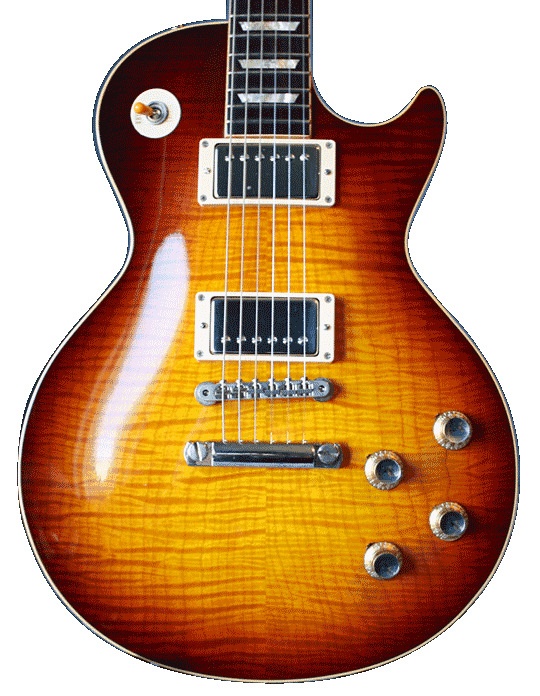
Get the latest reviews, guides and videos in your inbox.